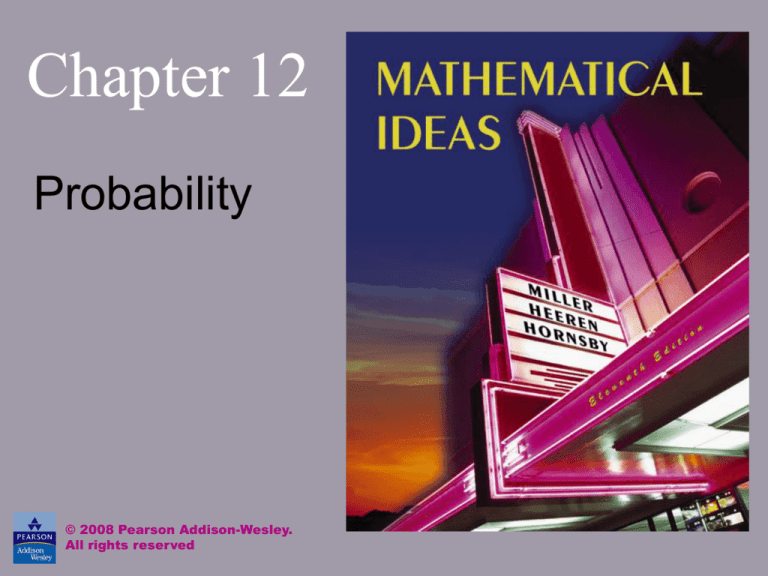
Chapter 12
Probability
© 2008 Pearson Addison-Wesley.
All rights reserved
Chapter 12: Probability
12.1 Basic Concepts
12.2 Events Involving “Not” and “Or”
12.3 Conditional Probability; Events Involving
“And”
12.4 Binomial Probability
12.5 Expected Value
12-2-2
© 2008 Pearson Addison-Wesley. All rights reserved
Chapter 1
Section 12-2
Events Involving “Not” and “Or”
12-2-3
© 2008 Pearson Addison-Wesley. All rights reserved
Events Involving “Not” and “Or”
• Properties of Probability
• Events Involving “Not”
• Events Involving “Or”
12-2-4
© 2008 Pearson Addison-Wesley. All rights reserved
Properties of Probability
Let E be an event from the sample space S. That is, E
is a subset of S. Then the following properties hold.
1. 0 P( E ) 1
(The probability of an event is
between 0 and 1, inclusive.)
2. P() 0
(The probability of an impossible
event is 0.)
3. P( S ) 1
(The probability of a certain event
is 1.)
12-2-5
© 2008 Pearson Addison-Wesley. All rights reserved
Example: Rolling a Die
When a single fair die is rolled, find the probability
of each event.
a) the number 3 is rolled
b) a number other than 3 is rolled
c) the number 7 is rolled
d) a number less than 7 is rolled
12-2-6
© 2008 Pearson Addison-Wesley. All rights reserved
Example: Rolling a Die
Solution
The outcome for the die has six possibilities:
{1, 2, 3, 4, 5, 6}.
1
a) P (3)
6
5
b) P (not 3)
6
c) P (7) 0
d) P (less than 7) 1
12-2-7
© 2008 Pearson Addison-Wesley. All rights reserved
Events Involving “Not”
The table on the next slide shows the
correspondences that are the basis for the
probability rules developed in this section.
For example, the probability of an event not
happening involves the complement and
subtraction.
12-2-8
© 2008 Pearson Addison-Wesley. All rights reserved
Correspondences
Set Theory
Logic
Arithmetic
Operation or
Connective
(Symbol)
Operation or
Connective
(Symbol)
Complement
Not
Subtraction
Operation or
Connective
(Symbol)
( )
( )
()
Union
Or
Addition
( )
()
()
Intersection
And
Multiplication
( )
()
()
12-2-9
© 2008 Pearson Addison-Wesley. All rights reserved
Probability of a Complement
The probability that an event E will not occur is equal
to one minus the probability that it will occur.
P(not E ) P( S ) P( E )
E
S
1 P( E )
E
So we have
P( E ) P E 1
and P( E ) 1 P( E ).
12-2-10
© 2008 Pearson Addison-Wesley. All rights reserved
Example: Complement
When a single card is drawn from a standard 52card deck, what is the probability that is will not be
an ace?
Solution
P (not an ace) 1 P(ace)
4
1
52
48 12
.
52 13
12-2-11
© 2008 Pearson Addison-Wesley. All rights reserved
Events Involving “Or”
Probability of one event or another should
involve the union and addition.
12-2-12
© 2008 Pearson Addison-Wesley. All rights reserved
Mutually Exclusive Events
Two events A and B are mutually exclusive events
if they have no outcomes in common. (Mutually
exclusive events cannot occur simultaneously.)
12-2-13
© 2008 Pearson Addison-Wesley. All rights reserved
Addition Rule of Probability (for A or B)
If A and B are any two events, then
P( A or B) P( A) P( B) P( A and B).
If A and B are mutually exclusive, then
P( A or B) P( A) P( B).
12-2-14
© 2008 Pearson Addison-Wesley. All rights reserved
Example: Probability Involving “Or”
When a single card is drawn from a standard 52card deck, what is the probability that it will be a
king or a diamond?
Solution
P (king or diamond) P(K) P(D) P(K and D)
4
13
1
52
52
52
16 4
.
52 13
© 2008 Pearson Addison-Wesley. All rights reserved
12-2-15
Example: Probability Involving “Or”
If a single die is rolled, what is the probability of a
2 or odd?
Solution
These are mutually exclusive events.
P(2 or odd) P(2) P(odd)
1
6
3
6
4 2
.
6 3
12-2-16
© 2008 Pearson Addison-Wesley. All rights reserved





